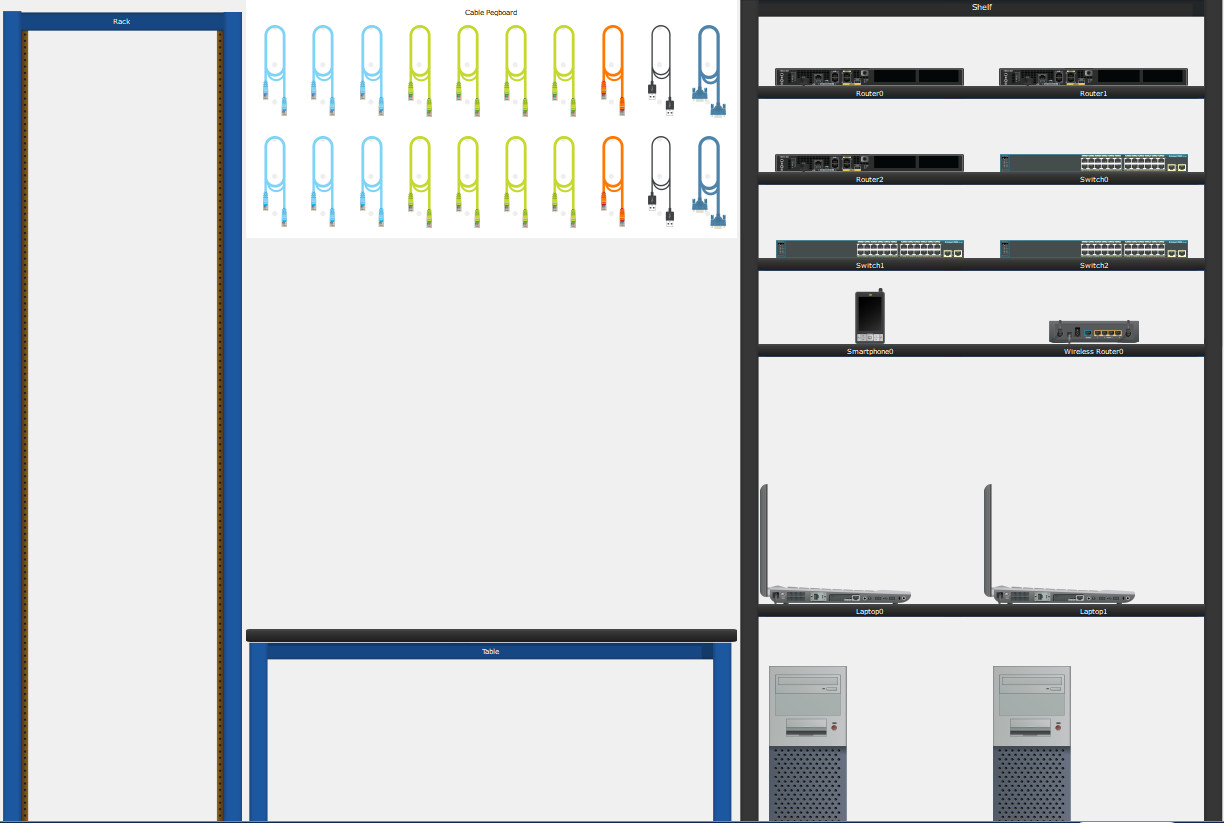17.8.1 Packet Tracer – Design and Build a Small Network – Physical Mode Answers

17.8.1 Packet Tracer – Design and Build a Small Network – Physical Mode
Objectives
Explain how a small network of directly connected segments is created, configured, and verified.
Background /Scenario
In this Packet Tracer Physical Mode (PTPM) activity, you will design and build a network from scratch. Your design must include a minimum of one Cisco 4321 router, two Cisco 2960 switches, and two PCs. Fully configure the network and use IPv4 or IPv6 (subnetting must be included as a part of your addressing scheme). Verify the network using at least five show commands. Secure the network using SSH, secure passwords, and console passwords (minimum).
Reflection Questions
1. What was the most difficult portion of this activity?
Answers will vary.
2. Why do you think network documentation is so important to this activity and in the real world?
Documentation is imperative to good network management. Without it, network administrators have to recreate topologies, physically check addressing, etc. This takes time, which could be used elsewhere.
Create a small network of directly connected segments, at a minimum 1 router, 2 switches and 2 PCs, and include a screenshot of the network in your final documentation.
Sample Topology:

Configure the network to include switches, routers, and end devices and use your own network addressing.You must use subnetting of some type and you can use either IPv4 or IPv6 logical addressing. Create a table showing your physical addressing scheme for the router, switch, and PC and include it in your final documentation.
| Device Name | IP Address | Subnet Mask |
|---|---|---|
| Cap_rtr | G0/0/0 – 192.168.1.1 G0/0/1 – 192.168.1.33 |
255.255.255.224 255.255.255.224 |
| Cap_sw1 | VLAN1 – 192.168.1.20 | 255.255.255.224 |
| Cap_sw2 | VLAN1 – 192.168.1.62 | 255.255.255.224 |
| Cap_PC1 | F0 – 192.168.1.10 | 255.255.255.224 |
| Cap_PC2 | F0 – 192.168.1 40 | 255.255.255.224 |
Verify the network by using show commands (at least 5) to provide a performance baseline. Be able to discuss why you chose the show commands you selected and what the output means (use all Packet Tracer activities for modules 1-17). Keep screenshots of your output and include in your final documentation.
Sample Show Command Output
Cap_rtr# show arp
ProtocolAddressAge (min)Hardware AddrTypeInterface
Internet192.168.1.1–00D0.9741.9101ARPAGigabitEthernet0/0/0
Internet192.168.1.101000A.4120.9039ARPAGigabitEthernet0/0/0
Internet192.168.1.33–00D0.9741.9102ARPAGigabitEthernet0/0/1
Internet192.168.1.40100D0.BCC3.BBEBARPAGigabitEthernet0/0/1
Internet192.168.1.6200060.4779.5A11ARPAGigabitEthernet0/0/1
Cap_rtr# show int g0/0/0
GigabitEthernet0/0/0 is up, line protocol is up (connected)
Hardware is Lance, address is 00d0.9741.9101 (bia 00d0.9741.9101)
Internet address is 192.168.1.1/27
MTU 1500 bytes, BW 1000000 Kbit, DLY 100 usec,
reliability 255/255, txload 1/255, rxload 1/255
Encapsulation ARPA, loopback not set
Full-duplex, 100Mb/s, media type is RJ45
ARP type: ARPA, ARP Timeout 04:00:00,
Last input 00:00:08, output 00:00:05, output hang never
Last clearing of “show interface” counters never
Input queue: 0/75/0 (size/max/drops); Total output drops: 0
Queueing strategy: fifo
Output queue :0/40 (size/max)
5 minute input rate 27 bits/sec, 0 packets/sec
5 minute output rate 23 bits/sec, 0 packets/sec
8 packets input, 1024 bytes, 0 no buffer
Received 0 broadcasts, 0 runts, 0 giants, 0 throttles
0 input errors, 0 CRC, 0 frame, 0 overrun, 0 ignored, 0 abort
0 input packets with dribble condition detected
7 packets output, 896 bytes, 0 underruns
0 output errors, 0 collisions, 1 interface resets
0 babbles, 0 late collision, 0 deferred
0 lost carrier, 0 no carrier
0 output buffer failures, 0 output buffers swapped out
Cap_rtr# show ip route
Codes: L – local, C – connected, S – static, R – RIP, M – mobile, B – BGP
D – EIGRP, EX – EIGRP external, O – OSPF, IA – OSPF inter area
N1 – OSPF NSSA external type 1, N2 – OSPF NSSA external type 2
E1 – OSPF external type 1, E2 – OSPF external type 2, E – EGP
i – IS-IS, L1 – IS-IS level-1, L2 – IS-IS level-2, ia – IS-IS inter area
* – candidate default, U – per-user static route, o – ODR
P – periodic downloaded static route
Gateway of last resort is not set
192.168.1.0/24 is variably subnetted, 4 subnets, 2 masks
C 192.168.1.0/27 is directly connected, GigabitEthernet0/0/0
L 192.168.1.1/32 is directly connected, GigabitEthernet0/0/0
C 192.168.1.32/27 is directly connected, GigabitEthernet0/0/1
L 192.168.1.33/32 is directly connected, GigabitEthernet0/0/1
Cap_sw1# show vlan brief
VLAN Name Status Ports
—- ——————————– ——— ——————————-
1 default activeFa0/1, Fa0/2, Fa0/3, Fa0/4
Fa0/5, Fa0/6, Fa0/7, Fa0/8
Fa0/9, Fa0/10, Fa0/11, Fa0/12
Fa0/13, Fa0/14, Fa0/15, Fa0/16
Fa0/17, Fa0/18, Fa0/19, Fa0/20
Fa0/21, Fa0/22, Fa0/23, Fa0/24
Gig0/1, Gig0/2
1002 fddi-default active
1003 token-ring-defaultactive
1004 fddinet-default active
1005 trnet-default active
Cap_sw2> traceroute 192.168.1.10
Type escape sequence to abort.
Tracing the route to 192.168.1.10
1 192.168.1.33 39 msec 0 msec 0 msec
2 192.168.1.10 13 msec 21 msec 15 msec
Secure the network using common configuration to include SSH, secure passwords, console security, etc. and verify the commands configured by enacting a show running-configuration screen as output. Include in your final documentation.
Cap_rtr# show run
Building configuration…
Current configuration : 831 bytes
!
version 15.4
no service timestamps log datetime msec
no service timestamps debug datetime msec
service password-encryption
!
hostname Cap_rtr
!
enable secret 5 $1$mERr$5.a6P4JqbNiMX01usIfka/
!
ip cef
no ipv6 cef
!
username SSHAdmin secret 5 $1$mERr$WvpW0n5HghRrqnrwXCUUl.
!
ip domain-name capstone.lab
!
spanning-tree mode pvst
!
interface GigabitEthernet0/0/0
ip address 192.168.1.1 255.255.255.224
duplex auto
speed auto
!
interface GigabitEthernet0/0/1
ip address 192.168.1.33 255.255.255.224
duplex auto
speed auto
!
interface Vlan1
no ip address
shutdown
!
ip classless
!
ip flow-export version 9
!
!
line con 0
password 7 0822455D0A16544541
login local
!
line aux 0
!
line vty 0 4
password 7 0822455D0A16544541
login local
transport input ssh
!
!
end
Identify elements of the model that map to real-world applications:
All facets of this activity map to IT-related content and real-world applications because this is a culminating activity for all the modules.
